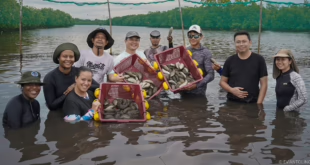GROWING up to a foot long, three to a kilo, and with a taste very much likened to lobster and tiger shrimp, one would wonder why not more people in the Philippines are farming freshwater prawns.
Locally known as ulang or pahi, the giant freshwater prawn (Macrobrachium rosenbergii) is the largest of its kind and is naturally found in river systems of the Philippines. Freshwater prawns immediately contrast from shrimps with their long claws that are up to twice their body length.
Dr. Frolan Aya, a scientist at the Southeast Asian Fisheries Development Center (SEAFDEC), says the prawn “is a promising alternative to tiger shrimp due to its high market value, high export potential and low susceptibility to diseases.”

Locally, a kilogram of giant freshwater prawn sells for an attractive P250 to P350 in the market. Although not nearly as valuable as tiger shrimp, freshwater prawns currently do not face the same risks of diseases as their distant crustacean cousin due to lower density culture practices.
Unlike tiger shrimp which require regular screening for diseases and facilities to keep out viruses and bacteria, freshwater prawns in extensive culture are mostly content with proper nutrition and good water quality. However, prawns are carriers of shrimp viral diseases as well, and thus farmers should still be careful not to pass on viruses to nearby shrimp farms.
Farmers can use simple ponds, cages, or even rice fields. “Cage culture is suited for marginalized fish farmers who have no land to develop into ponds and requires minimal start-up investment,” shared Dr. Maria Lourdes Aralar, a SEAFDEC retired scientist who largely developed the technology for lake-based cage culture.
The simplicity of freshwater prawn farming means it is widely farmed across Southeast Asia such as in Viet Nam which produced 547 thousand tons in 2014 with Thailand coming a far second at 17 thousand tons. However, Philippine farm production in 2014 was only 9 tons although 1,700 tons was sourced from the wild.

Need for more hatcheries
The bottleneck in Philippine production is not in the number of prawn-growing ponds and cages but in the production of postlarvae. These are the tiny young prawns that are hatched and nursed in hatcheries for 28 to 35 days before taking them out to tanks, ponds or lake cages.
“I think the production is very limited for a lack of sufficient quantity of postlarvae for grow-out, but it has the potential to form an aquaculture industry,” said Aya.
Training for those interested in the hatchery and grow-out of giant freshwater prawn is regularly offered by SEAFDEC at its Binangonan Freshwater Station in Rizal. The station also produces postlarvae as byproducts of its research activities which it makes available to prawn farmers.
Currently, other sources of postlarvae are the Bureau of Fisheries and Aquatic Resources (BFAR) National Freshwater Fisheries Technology Center in Nueva Ecija and National Integrated Fisheries Development Center in Pangasinan.
Dan Baliao, chief of SEAFDEC Aquaculture Department (AQD) also revealed that they recently developed an initial prawn hatchery operation in Tigbauan, Iloilo with currently about 3,000 broodstock.
“We are just starting, but once construction of our bigger Macrobrachium rosenbergii hatchery is finished, we are really looking at mass producing postlarvae here at Tigbauan to provide farmers with seeds and to again jumpstart the giant freshwater prawn industry,” he said. / RD DIANALA

 SEAFDEC/AQD Southeast Asian Fisheries Development Center | Aquaculture Department
SEAFDEC/AQD Southeast Asian Fisheries Development Center | Aquaculture Department



